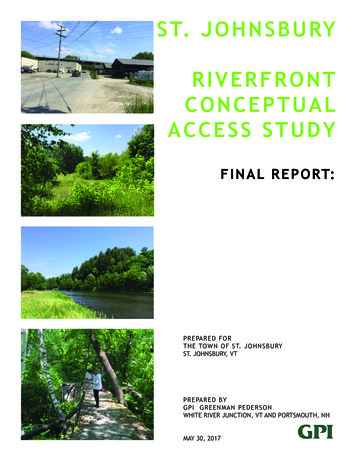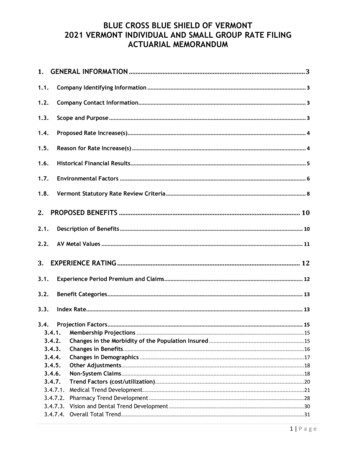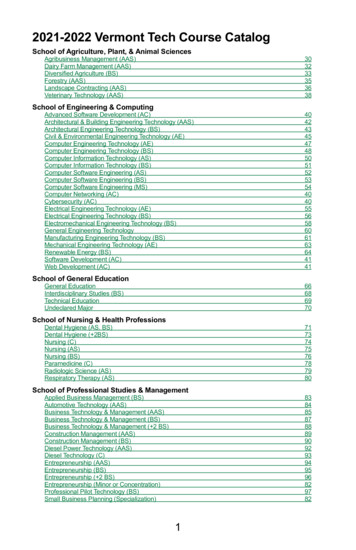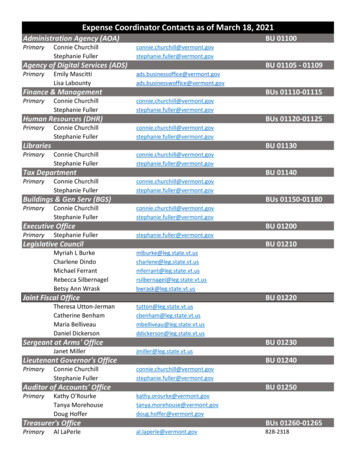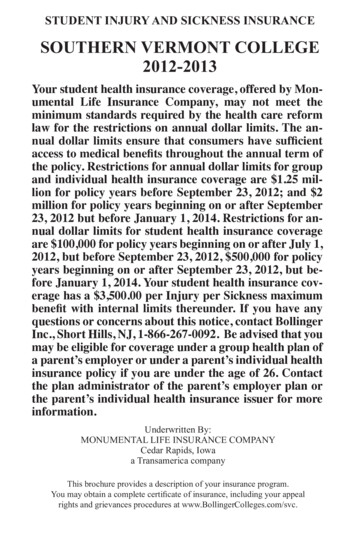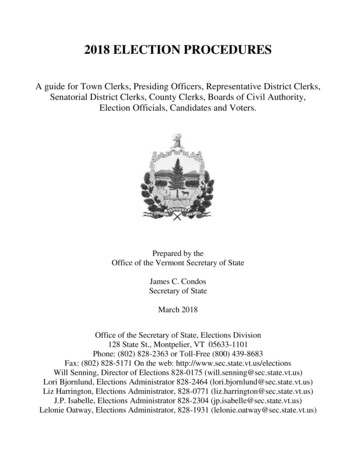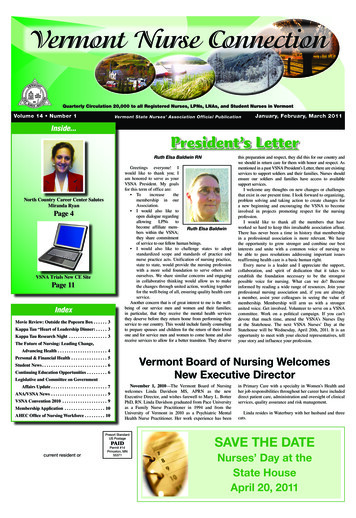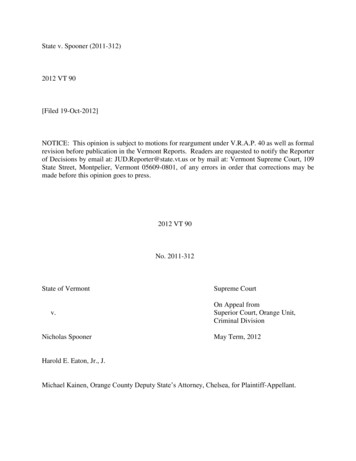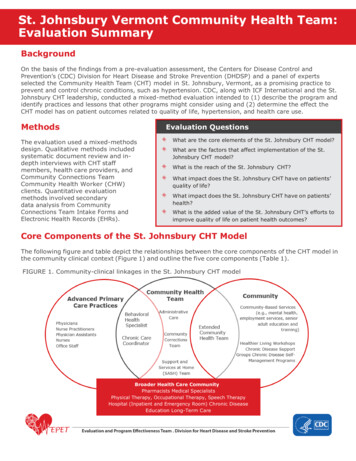
Transcription
St. Johnsbury Vermont Community Health Team:Evaluation SummaryBackgroundOn the basis of the findings from a pre-evaluation assessment, the Centers for Disease Control andPrevention’s (CDC) Division for Heart Disease and Stroke Prevention (DHDSP) and a panel of expertsselected the Community Health Team (CHT) model in St. Johnsbury, Vermont, as a promising practice toprevent and control chronic conditions, such as hypertension. CDC, along with ICF International and the St.Johnsbury CHT leadership, conducted a mixed-method evaluation intended to (1) describe the program andidentify practices and lessons that other programs might consider using and (2) determine the effect theCHT model has on patient outcomes related to quality of life, hypertension, and health care use.MethodsEvaluation QuestionsThe evaluation used a mixed-methodsdesign. Qualitative methods includedsystematic document review and indepth interviews with CHT staffmembers, health care providers, andCommunity Connections TeamCommunity Health Worker (CHW)clients. Quantitative evaluationmethods involved secondarydata analysis from CommunityConnections Team Intake Forms andElectronic Health Records (EHRs).What are the core elements of the St. Johnsbury CHT model?What are the factors that affect implementation of the St.Johnsbury CHT model?What is the reach of the St. Johnsbury CHT?What impact does the St. Johnsbury CHT have on patients’quality of life?What impact does the St. Johnsbury CHT have on patients’health?What is the added value of the St. Johnsbury CHT’s efforts toimprove quality of life on patient health outcomes?Core Components of the St. Johnsbury CHT ModelThe following figure and table depict the relationships between the core components of the CHT model inthe community clinical context (Figure 1) and outline the five core components (Table 1).FIGURE 1. Community-clinical linkages in the St. Johnsbury CHT modelBroader Health Care CommunityPharmacists Medical SpecialistsPhysical Therapy, Occupational Therapy, Speech TherapyHospital (Inpatient and Emergency Room) Chronic DiseaseEducation Long-Term Care
Table 1. Core Components of St. Johnsbury CHT ModelCore ComponentsAdministrative CoreFunctional HealthTeamCommunityConnections TeamDescriptionA program manager provides managerial and programmaticsupport, as well as oversight, for the CHT. A care integrationcoordinator is responsible for overseeing CHT components andactively building and sustaining partnerships with communityorganizations collectively known as the Functional Health Team.The Functional Health Team comprises approximately 30 communitypartners that provide a variety of services to the community. TheFunctional Health Team helps establish and maintain relationshipsthat facilitate linkages between the community and clinical entities.The Community Connections Team consists of CHWs and a chroniccare CHW. Two CHWs are primarily responsible for linking clients tocommunity-based and local state agencies that provide financial andother tangible resources to meet clients’ needs, such as vouchers forheating and transportation assistance. A chronic care CHW providessimilar services, but primarily acts as a health coach to clients toimprove their self-management skills related to chronic disease.The Community Connections Team is managed by the careintegration coordinator to promote integration with the larger CHT.AdvancedPrimary CarePracticesThe St. Johnsbury CHT model includes National Committee for QualityAssurance (NCQA)–recognized patient-centered medical homes, referredto as Advanced Primary Care Practices (APCPs).Working in collaboration with the health care providers, officestaff, and other CHT members, chronic care coordinators areresponsible for coordinating the care of patients with or at risk forchronic conditions.Behavioral health specialists provide short-term, solution-focusedtherapy to patients (three to eight sessions). They refer patientsrequiring long-term mental health services to mental healthproviders in the community.Support and Services atHome*Support and Services at Home (SASH) teams connect Medicarepatients with health and long-term care systems in an effort to allowindividuals to remain living at home safely. The SASH componentimplements specific interventions for the following key areas: fallprevention, medication management, control of chronic conditions,healthy behaviors, and cognitive and mental health issues. SASH wasintegrated into the St. Johnsbury CHT model in 2012.*This component was not included in the original scope of the VT CHT evaluation plandrafted in 2011.
Key FindingsThe following are key findings related to the implementation, reach, and impact of the St. Johnsbury CHTmodel.Factors Affecting ImplementationFacilitatorsThe CHT members and partners are familiar with one another and understand each other’s rolesand areas of expertise. These relationships help to facilitate collaboration.The CHWs on the Community Connections Team have a strong commitment to patients.Health care providers strongly support the CHT’s implementation.Chronic care coordinators and behavioral health specialists are located within the APCPs.BarriersThe workload for CHWs can be demanding at times.Chronic care coordinators and behavioral health specialists have to balance their time and workloadacross multiple APCPs.CHWs link clients with State and community resources for additional services. Sometimes, otheragencies have very specific funding streams that may restrict the target population or the types ofservices that can be provided. These limitations can make it difficult for CHWs to secure assistancefor patients.The role of the chronic care coordinator is interpreted differently across APCPs, resulting inturnover and difficulty hiring professionals with the right experience for this position.ReachThe St. Johnsbury hospital service area covers approximately 30,000 adults. As of March 2012,about 22,106 unique patients were cared for by the 5 APCPs in the CHT.All 5 primary care practices serving adults in the St. Johnsbury hospital service area are part of theCHT. This includes 29.5 primary care providers.Health Care Practice-Level OutcomesReaching a population in need.–Clients served by the Community Connections Team CHWs, chronic care coordinators, andbehavioral health specialists appear to have more health needs than other medical homepatients. A higher proportion of CCT clients were either insured by Medicaid, were currentsmokers, or had diabetes comorbidity compared with other medical home patients.Improved community-clinical linkages and enhanced care coordination.–Providers indicated that the CHT model allows them to link patients to other CHT membersfor support in addressing a full range of patient needs.–Higher proportions of patients exposed to one CHT component were also exposed to otherCHT components. For example, among Community Connections Team CHW clients, nearlyhalf were also patients of chronic care coordinators. Meanwhile, less than 10% of all Medicalhome patients were exposed to a chronic care coordinator. This suggests CHT staffsuccessfully work together to coordinate care for the clients they serve.Streamlined primary care practice and increased efficiency.–Health care providers who participated in the evaluation expressed that the CHT model hashelped to streamline their practices. The model provides opportunities for providers to usethe limited time available during patient encounters to provide more comprehensive care.Providers also reported needing to do “less teaching and more referring,” making office
visits shorter.–The location and proximity of CHT staff within the primary care practices allows providers totake care of patients sooner and link them to services that will help get them out of crisismode. Patients can get mental health services and other needs met often on the same dayas their primary care visit.Patient-Level OutcomesQuality of Life OutcomesImproved well-being and increased support to address issues related to the social determinants ofhealth.–There were statistically significant improvements among CHW clients in key aspects of wellbeing targeted by the Community Connections Team including health insurance, prescriptiondrugs, housing, and health education. These areas align with constructs associated withsocial determinants of health and Healthy People 2020 objectives. Analyses indicate thatthese improvements may represent the difference of a client in a crisis situation and makingprogress towards stability.–CHW clients reported improvements in well-being because CHWs helped them with gettingtheir basic needs met, such as completing “daunting” paperwork that resulted insupplemental nutrition assistance benefits, heating oil, supplemental income, support forhearing and sight aids, improved financial management, and housing assistance.Health OutcomesIncreased attentiveness to overall health.–CHW clients who participated in in-depth interviews reported that they were more awareand attentive to their overall health after receiving services from the CommunityConnections Team. This suggests that CHW efforts have the potential to ultimately impactthe overall health of clients.–CHW clients also reported that getting assistance with prescriptions and transportation toappointments helps them manage their overall health. This suggests that CHWs efforts mayhelp individuals better manage chronic conditions, such as hypertension.Increased patient adherence to treatment.–Primary care providers provided examples of patients who had dramatic changes in theirhealth as a result of engaging with the CHT members, highlighting how the CHT hascontributed to increasing patient adherence to treatment protocols. Examples includedbetter compliance due to patient-led goal setting, making follow-up appointments, andemploying tools to improve medication use.ConclusionsThe St. Johnsbury CHT model is an example of a multidisciplinary coordinated team offering communityclinical linkages to a high need population in the community. Team members address clients’ socialdeterminants of health and provide an environment of support and empowerment so individuals can moreeffectively manage their health conditions. There is increased interest to implement and expand publichealth interventions that effectively address socioeconomic factors, the broadest base of the health impactpyramid, as these have the greatest potential population impact with the least required effort. While thefindings from this study are inconclusive with regards to the effectiveness of the CHT model on long-termhealth outcomes like hypertension control, there are a number of findings supporting short-term patientlevel outcomes that may lead to improved chronic disease management, including hypertension. Equallyimportant are the benefits that this model brings to the health care system, including greater practiceefficiencies, improved patient-centered holistic care, and patient adherence to treatment protocols.
Considerations for Program ReplicationThe following are some important key lessons to consider when replicating the St. Johnsbury CHTmodel:Conduct a systematic assessment of a community’s needs and assets to help develop a programsimilar to the CHT model.Identify appropriate and sustainable funding sources for core CHT members.Provide early involvement to help facilitate collaboration and promote shared ownership of theteam.Identify a program manager to provide oversight and serve as a central point of contact for theteam.Identify a team member to serve as a care integration coordinator. The coordinator plays an activerole in building and sustaining partnerships between the clinical entity and communityorganizations.Collaborate regularly with a team of community organizations, such as the Functional Health Team,to help facilitate linkages between clinical and community entities.NotesFor more details on the evaluation study findings, implications, recommendations, and limitations,please send an e-mail to arebheartinfo@cdc.gov.Additional implementation information can be found in the Implementation Guide for Public HealthPractitioners: The St. Johnsbury Community Health Team Model, available on the CDC DHDSP Web sitehttp://www.cdc.gov/dhdsp/evaluation resources.htm.Disclaimer: The opinions and conclusions are those of the authors and do not necessarily represent the officialposition of the Centers for Disease Control and Prevention.Financial Disclosure/Funding: This work was supported in part by a contract (Contract Number 200-2008-27957) from theCenters for Disease Control and Prevention.August 2014
The St. Johnsbury hospital service area covers approximately 30,000 adults. As of March 2012, about 22,106 unique patients were cared for by the 5 APCPs in the CHT. All 5 primary care practices serving adults in the St. Johnsbury hospital service area are part of the CHT. This includes 29.5 primary care providers. Health Care Practice-Level .
